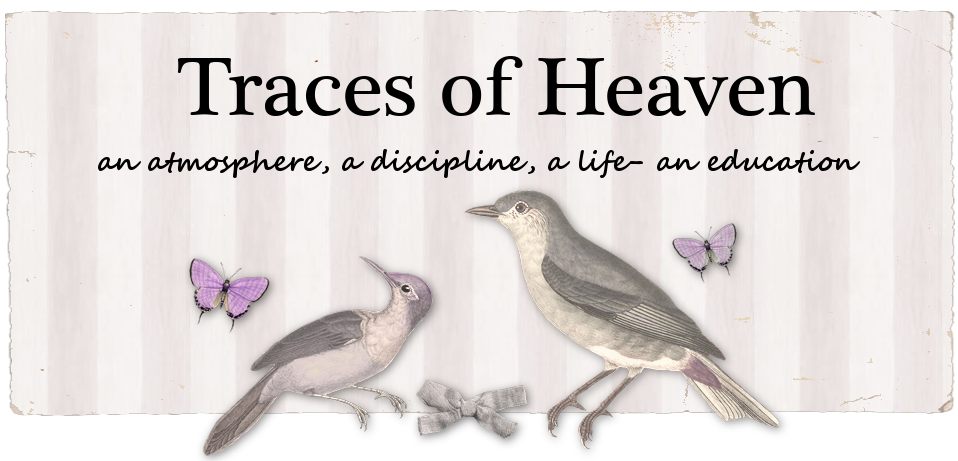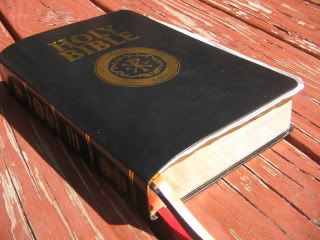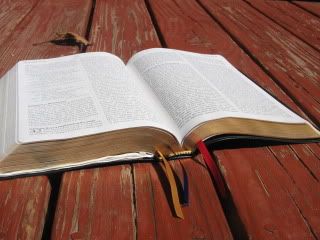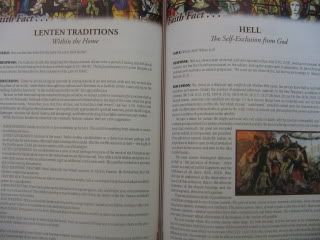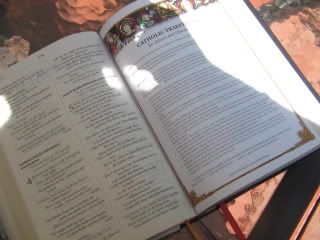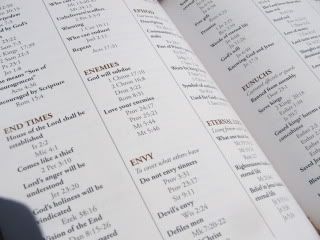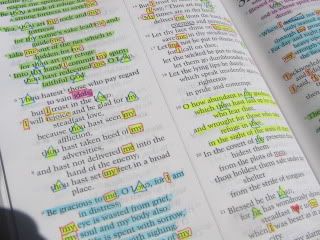I have been anxiously awaiting the release of the COMPLETE Scott Hahn Study Bible, and getting discouraged with the wait. I looked around to see if there were any other attempts at creating an orthodox study bible for Roman Catholics that made understanding Scripture more accessible, and randomly found this little gem in my favorite Bible publishing house, no less..... St Benedict Press/Tan Books.
I was intregued! Though I hadn't heard much about it in Catholic Bible blogs (why not? Anybody know??), here was a bible that promised to combine my two favorite elements: Orthodox, Catholic Commentary from a reputable source and the Revised Standard Version, Catholic Edition of the Bible. I was ecstatic to check it out, and I am still elated even though it's about two months later (the Bible arrived just before my vacation and I wasn't able to do the review while I was gone.) Of course, I read it every day on my vacation, used it to back up a point I was making in a dialogue with a French priest we had over, and have since passed it around to the girls in my Bible Study, who all seemed excited to check it out themselves. So as promised, here is my review of the St Benedict Press / Catholic Scripture Study International Bible.
First, the Cover and Design:
I absolutely LOVE the Look of this bible. It is an exact replica of the St Benedict Press LARGE Print RSV with a redesigned cover. I was sad to see my St Benedict cross go on the cover, but at the same time, I love the CSS Logo and there's just something so incredibly AWESOME about having a Bible that says "tradition/scripture/magisterium" right on the cover. It has the thick, heavy look of lots of protestant study Bibles out there which appeals to me (I dig the black leather look. Some do not. ) It also has three different colored ribbons, which make it marvelous to use because you definitely NEED about three ribbons to do any kind of "studying" in a Bible (ie, flipping between passages, etc.) The leather on the cover is thinner and less substantial than the leather on the plain edition of the RSV sold through Benedict Press, but it is certainly nice and will stand up to a lot of wear.
Another thing I like is the size. It's BIG, which I wanted, but not so big that you need two hands to read it all the time, which means I can still read it in bed. Like! I also think St Benedict Press does such an amazing job with the bookbinding and all that. It lays pretty flat and is super flexible, which I LOVE in a Bible (can't stand stiff Bibles, which is why I am sad about the Baronius Press Douay Rheims.) On the other hand, it's not so flexible that you worry it's going to fall apart within a week of heavy use. This is a "lifetime" Bible investment. Some of us will wear it out in a few years, but you know what I mean. It is very good quality. Don't mind the wavy bits in the pictures here, I forgot to take out all the "add in" sheets I carry around everywhere when I took the pictures, and the wavy pages are actually not part of this Bible.
Next, the features:
As I said before, this bible is an exact replica of the St Benedict Press Large Print RSV-CE, with the addition of a series of glossy inserts on various topics ranging from apologetics to lenten traditions. These inserts are very informative, orthodox, and helpful. I used to carry around a two page printout I call the Apologetics Cheat Sheet on which I had printed all the scripture references for the various Catholic doctrines we must always defend.... it's amazingly brilliant that this bible includes that (FOR ONCE a Bible that is as thorough as it SHOULD be in my eyes!) and I can now stop carrying around my nasty old laminated sheet. Yay!
I also used to carry around various sheets with reference to the Church's teachings on specific topics, and they are ALL present here in this Bible, which is wonderful and very freeing for me. For once I feel like the people who designed this Bible are people who have the same concerns that I do: understanding the Faith, defending the faith, and hearing from God for my personal life. In that order. And they aren't afraid to make some enemies.... (hooray!) the inserts contain topics that address hell, the myth of overpopulation and the culture of death, and the errors of protestant biblical interpretation.
The last several pages are actually an amazing reference tool similar to the concordances we are used to seeing in Protestant Bibles. They contain an alphabetical list of subjects and their corresponding locations in scripture. The topics are practical in nature and applicable in daily life. It is a GIFT to Catholics everywhere, especially Catholics who are poorly catechized or don't really KNOW their Bibles, to be able to have such an easy reference table without having to make it oneself. I love this feature.
And lastly, the page design itself:
Large print, beautiful typeface, very readable. I admit, I really want to have the footnotes in the text, but they aren't-- they are in the back of each testament. And they are sparse. Which is fine, as long as they are in there, but since the notes are just the regular RSV notes with nothing added, which was kind of a bummer. I had hoped the guys at CSS would have included additional notes to help us add meaning to the text bit by bit. At the same time, I find that since the RSV doesn't have footnotes, I'm not tempted to READ them instead of the text, which means that A) I read more scripture and B) I'm not as influenced by the notes in my reading since they aren't in my face. So even though it's less esthetically pleasing -- to me-- to have JUST the text without any breaks for notes, it's actually more profitable for my bible reading time.
The pages are thin.... I include some of the pages on which I have made notes so you can see that pen bleeds through pretty good. I don't personally care about that but many of you bible snobs out there (tee hee) will likely have a fit if you buy a bible that has pages this thin. Personally, I actually LIKE that it shows through... helps me to feel like I'm accomplishing some work in my daily Bible study. :D
A few notes on the translation:
Many people wonder why we might read an RSV instead of the NAB, which is the version of the Bible selected and promoted by the United States Catholic Bishops for American Catholics. That alone might make people shy away from the RSV-CE, but let me reassure you: the Vatican ONLY uses the RSV-CE when publishing scripture quotations in English.
The RSV-CE is NOT the 2nd Edition revision of the RSV-CE. Therefore the text retains SOME of the thees and thous without overdoing it and rendering it unreadable to the average modern reader. However, it also retains some of it's eceumenical nature which has been weeded out in the RSVCE SECOND Edition.
I absolutely love the RSV, which I think is more readable than the Douay Rheims but far closer to the DR's "perfect" translation than the absolutely frustrating New American Bible, which contains notes using the historical-critical method that absolutely boggle the Orthodox Catholic mind. (and not in a good way.) I also love that the RSV retains much of the original style we have come to love... in psalm 23, for example, we don't "dwell in the house of the Lord for years to come" as we did in the New American Bible. We dwell in the house of the Lord FOREVER. As it was written. (why the NAB does this is beyond me. I've lost enough sleep over it and am not even going to bother ranting... but do know that -- praise God-- the NAB seems to be doing a little better with the release of the NABRE (revised NAB) in which we, for example, now "dwell in the house of the Lord for endless days.")
Anyways, all this to say that like any translation, the RSV has it's bad points, but to me the good outweighs the bad... if only they would get some more thorough footnotes going it would be hands down the ideal Bible Version.
So that's it.... the CSS Study Bible is incredible, as perfect a Catholic Study Bible is going to get until we are able to have some textual notes that don't make us cringe and that actually contain the Old Testament, which is, you know, half the story. I am so thankful for CSS putting this Bible together and I will be passing it around to everyone I know and making it my every day Bible. Go ahead and pick yourself up a copy. You will be so glad!
Those of you who are local will probably get to hear all about how it came to be this year when we finally get Gail to come out and speak. I know you're going to love it.
If you have any questions about this Bible, please feel free to comment below. I don't make taking additional pictures and what not if you need them. Thanks!
ADDITION: In an email this morning, Gail pointed out a few things that I thought should be included. First, she explained that she thinks of this bible as a reference Bible and not a Study Bible, and upon reflection I can definitely see that calling it a reference Bible is the optimal explanation.... it contains all of the bits and pieces many of us carry around in our bibles, but doesn't contain all of the notes that would be required to dig into the actual text line by line.
She also mentioned the origin of the illustrations, which I forgot to mention. They are beautiful!! They came from a monk in Europe who loves to take pictures of stained glass windows. It is so refreshing to own a bible that doesn't have pictures of Jesus that look like they walked off the walls of some 1970s CCD class. These are pictures of stained glass windows that are uplifting, beautiful, and calming. Soul-stirring. and the rest of the design of the Bible (borders, etc) on the notes pages go along with the illustrations perfectly.
Enjoy this Bible..... from my discussions with her and just from having used the thing myself for a couple of months now, I can see what a beautiful labor of love it really is.
ADDITION: In an email this morning, Gail pointed out a few things that I thought should be included. First, she explained that she thinks of this bible as a reference Bible and not a Study Bible, and upon reflection I can definitely see that calling it a reference Bible is the optimal explanation.... it contains all of the bits and pieces many of us carry around in our bibles, but doesn't contain all of the notes that would be required to dig into the actual text line by line.
She also mentioned the origin of the illustrations, which I forgot to mention. They are beautiful!! They came from a monk in Europe who loves to take pictures of stained glass windows. It is so refreshing to own a bible that doesn't have pictures of Jesus that look like they walked off the walls of some 1970s CCD class. These are pictures of stained glass windows that are uplifting, beautiful, and calming. Soul-stirring. and the rest of the design of the Bible (borders, etc) on the notes pages go along with the illustrations perfectly.
Enjoy this Bible..... from my discussions with her and just from having used the thing myself for a couple of months now, I can see what a beautiful labor of love it really is.
